Romance and Rituals of Traditional Weddings in Karnataka are blessed with simplicity and serenity rather than glitz and glamour.
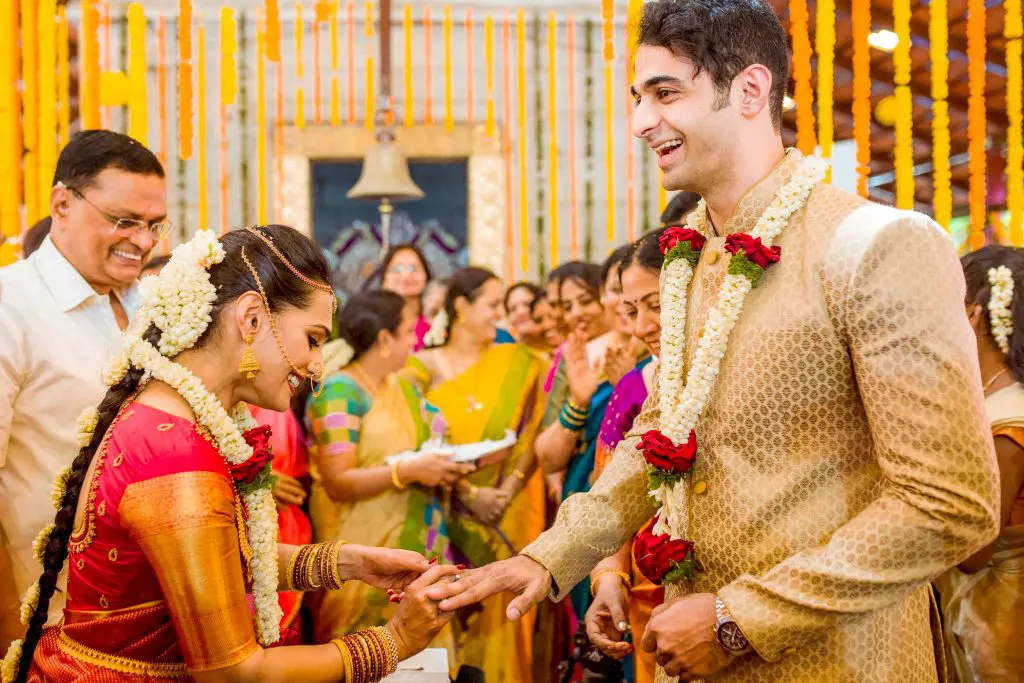
When one witnesses a wedding in Karnataka, one can sense the land of God reciting mantras and instilling serenity within. Weddings in Kannada are typically short and share many practices with nearby states like Maharashtra and Andhra Pradesh. Kannada weddings are usually held throughout the day and last only a few hours to a few days.
Pre-wedding Rituals
- Nischay Tamulam – The horoscopes of the prospective bride and husband are matched during an arranged marriage. Whenever the stars align perfectly then weddings take place, suggesting a happy and wealthy future. The parents approve of the match and offer a plate of betel leaves and betel nuts in exchange. The kadda equivalent of an engagement ceremony is Nischay Tamulam. The priest also selects the wedding’s favourable time and date.
- Naandi – The Naandi ceremony is held a few days before the wedding in both the bride’s and groom’s homes. The purpose is to ensure that the wedding ceremony goes according to plan, and is conducted by the family priest. The wedding festivities begin with the placement of a traditional copper pot, or kalash, laden with holy water and topped with a coconut. This ceremony ensures that the pair is blessed with a life of abundance, health, wisdom, and longevity since the pot represents a pot of Amrit or the Nectar of Life.
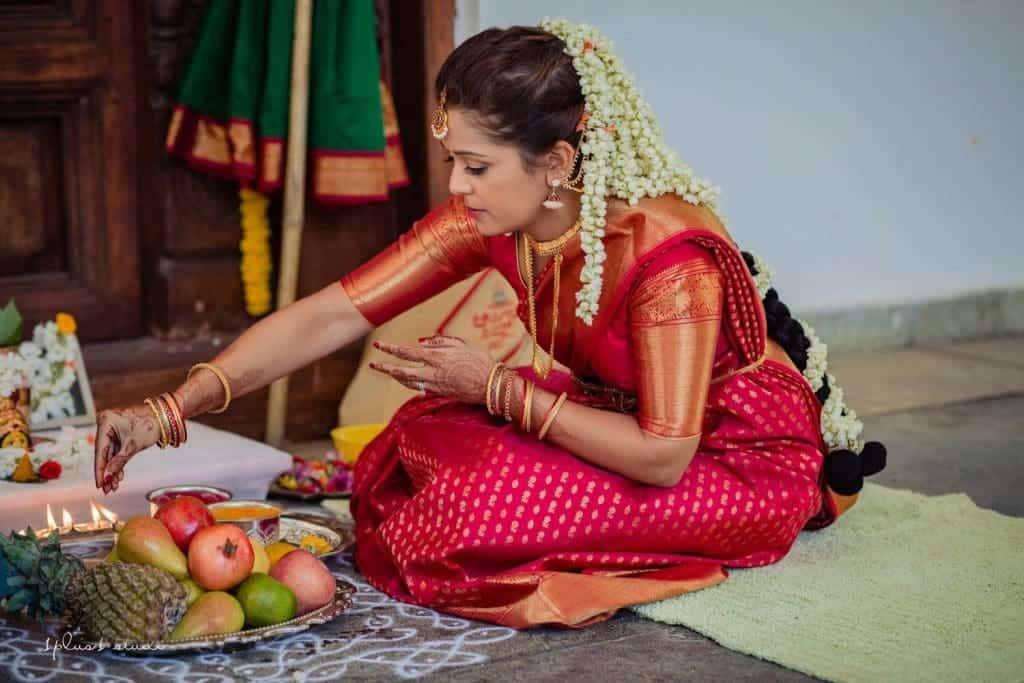
- Kaashi Yaatre – In Kashi Yatra, the man pretends to be enraged because he can’t locate a suitable bride and leaves the house to go on a pilgrimage. His maternal uncle steps in and recommends a suitable spouse for him. After that, the groom changes his mind and decides to marry his bride at home. This appears to be an intriguing watch!
- DevKarya – On the day of the wedding, when the groom is leaving home, he visits temples in his neighbourhood to seek blessings from all the gods. The items that will be utilised during the wedding are placed in front of Lord Ganesh to obtain his blessing and to purify them.
Wedding Rituals
- Mandap Pooja – The term “mandap” refers to the place where all of the upcoming wedding rites will be conducted. Before anything else, the priest conducts a puja to purify the mandap as well as the wedding location.
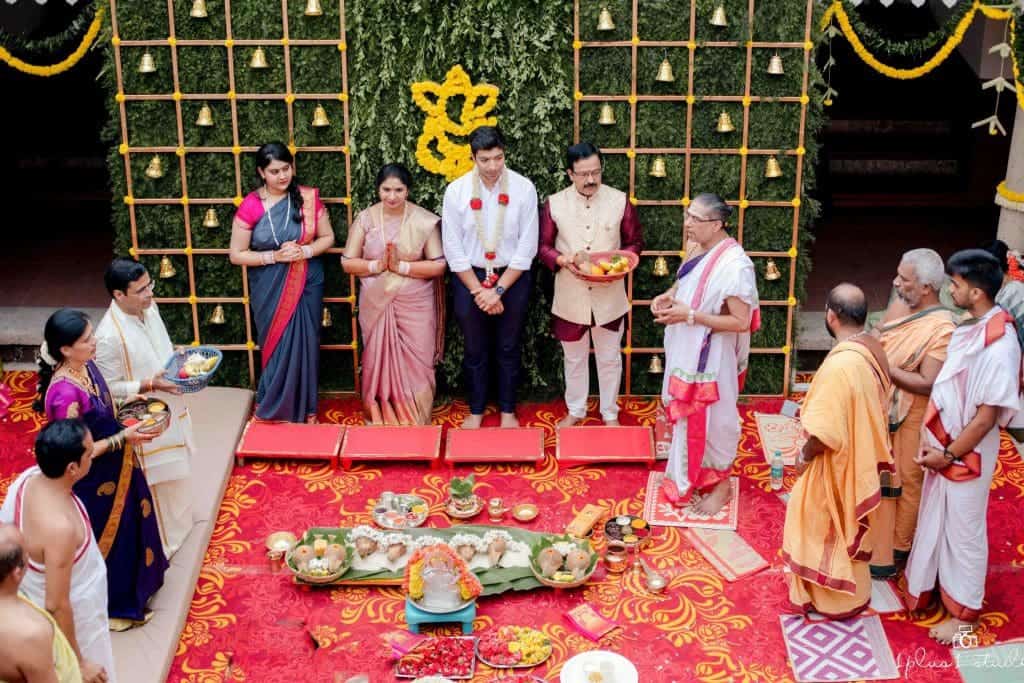
- Var Puja – The groom is thought to be a reincarnation of Lord Vishnu in the Hindu religion. In this regard, the bride’s side worships him. His future father-in-law accompanies him to the wedding mandap, where he is seated in a prominent position. The bride’s father washes his feet, and a puja is done in his honour. He is also given a pitambar, which is a silk dhoti and scarf combo.
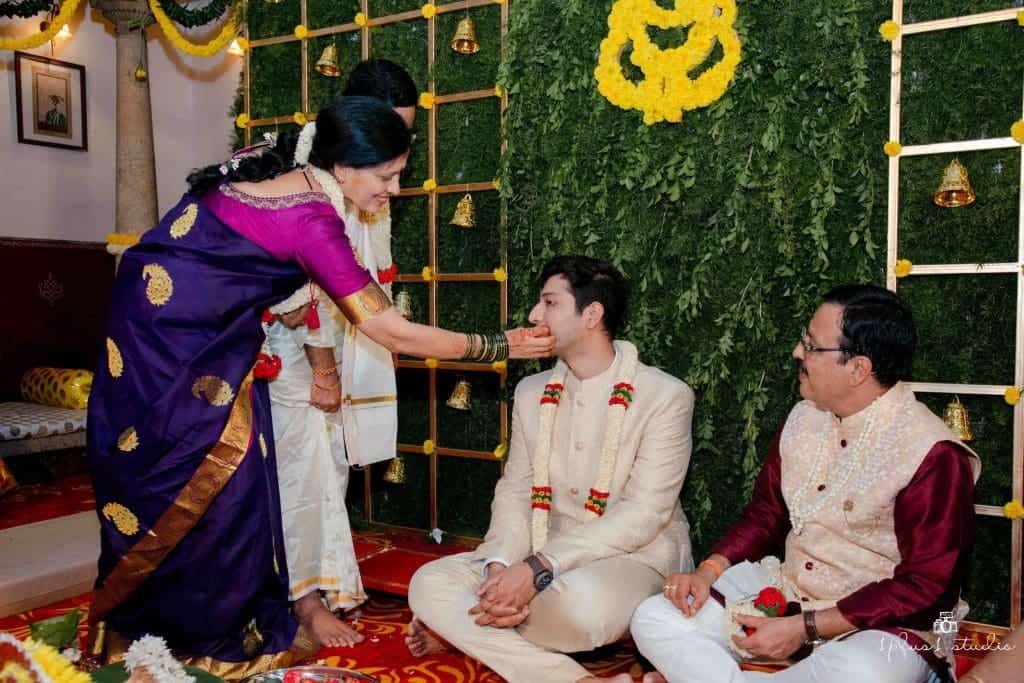
- Jaimala – After that, the bride is taken to the wedding mandap. Her face is hidden under a fan crafted of peacock feathers. She is usually accompanied by her sister, who shields the bride’s face with a peacock feather fan. The bride takes her seat on the mandap, and a textile curtain separates the bride and groom, blocking them from seeing each other. The priest chants the wedding rites’ opening mantras, and the curtain slowly lifts, allowing the couple to see each other for the first time. After that, the bride and groom exchange Malas (flower garlands) three times.
- Dhare Herdu – The bride’s parents then perform the tradition of giving their daughter to her new spouse. It’s similar to the kanyadaan ceremony used in other Hindu weddings. The bride’s right hand is put on the groom’s right hand. A coconut and a betel leaf are placed above the bride’s palm. The bride’s parents then bless and approve the union by pouring holy water on top of the couple’s linked hands.
- Saptapadi – The bride and groom must next walk seven circles around the fire as part of the Saptapadi ceremony. But first, a knot is tied between both the loose ends of the bride’s and groom’s clothes, signifying the two souls’ eternal relationship. The groom then ties a ceremonial turmeric-dipped thread around the bride’s neck. It’s called the Mangalsutra. The ceremony is now finally over, and the two are regarded as husband and wife.
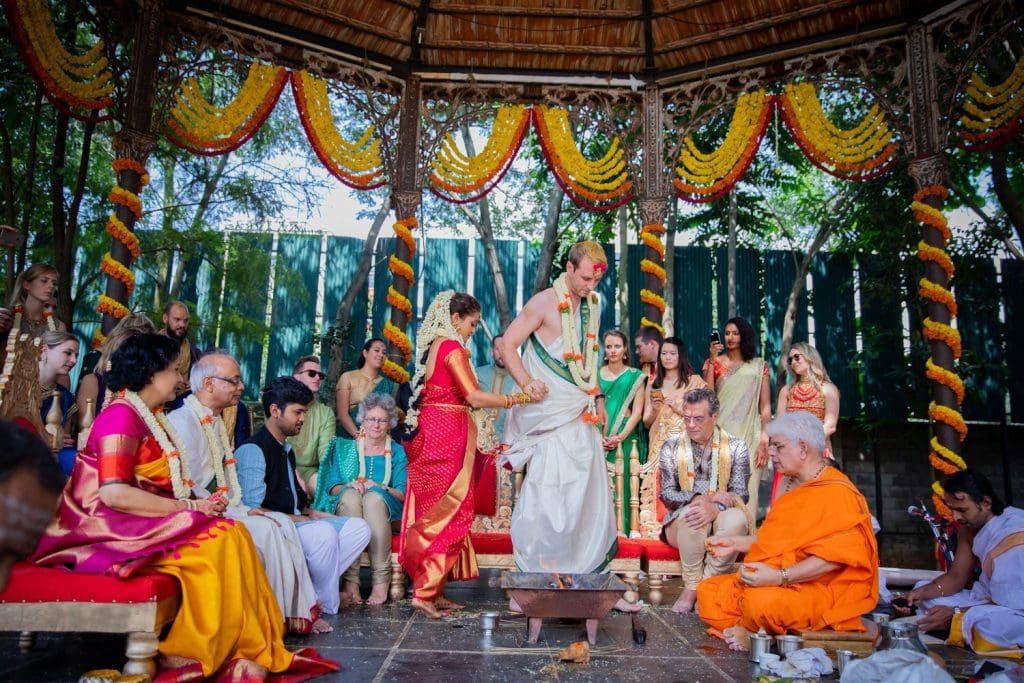
Post-wedding Rituals
- Okhli – After the wedding ceremonies have been completed Kannadigas play Okhli, a post-wedding game. The groom’s ring is tossed into a glass of milk or coloured water. The bride has three chances to dip her hands inside the vase and find the ring. If the bride finds the ring, it is expected that she will be able to handle any marital life challenges that may arise in the future.
- Vidaai – It’s finally time for the bride to say her goodbyes to her family after all of the ceremonies and games have concluded. The bride is sent off to her new home with presents that are needed to set up a new home, such as furniture, utensils, sweets, and so on, according to Kannada wedding tradition. In addition, the bride’s brother visits his sister at her husband’s home, stays the night, and returns the next day.
- Griha Pravesh – When the bride arrives at her in-house, law’s she is greeted warmly by the groom’s family. Aarti is performed by her mother-in-law as a welcome. Before entering the Griha Pravesh residence, the bride overturns a vessel loaded with rice on the ground at the entrance door.
- Name Change Ceremony – The bridegroom chooses a new name for his wife during this time. He must use his ring to write the name on a plate of rice. The bride accepts the plate, signalling her acceptance of her new name.
- Visiting the bride’s house – The bride’s parents arrive at the groom’s house on the second day of the wedding to transport the pair to their home. Before returning to the groom’s home, the newlyweds are expected to remain at least one night.
- Reception – The groom’s family hosts a reception to introduce the bride to her relatives, friends, and loved ones.
Wedding Attire
The groom wears a white veshti or dhoti around his waist in the traditional South Indian way. It could be constructed of basic cotton or silk, with thin but decorative borders. A white kurta or sherwani is worn with the veshti, but during the wedding ceremony, the groom must wear an Angavestram, a matching white silk scarf. He must wear Pheta or Pitambar, a turban-like headwear that might be white or orange in hue. The groom holds a stick in his right hand, which must be blessed by a priest in a temple before the wedding day.
The bride’s wedding dress is incredibly ornate. She is dressed in a traditional Naavari saree that is 9 yards long. They are similar to Maharashtrian brides in that they wear green glass bangles with their sarees. The bride is decked out with gold jewellery, including a Mangtika, many gold necklaces, and a Jhumka in her ears, as well as a Kamarbandh around her waist. Her hair is styled in a typical high bun and plait, and she has a lot of flowers in it.
Food
- Masala Dosa – Anyone’s mouth will water just hearing the term. It’s made with the same batter that’s used to make idlis. The potato curry, which is made with potatoes, peas, and chillies, is stuffed into the dosa.
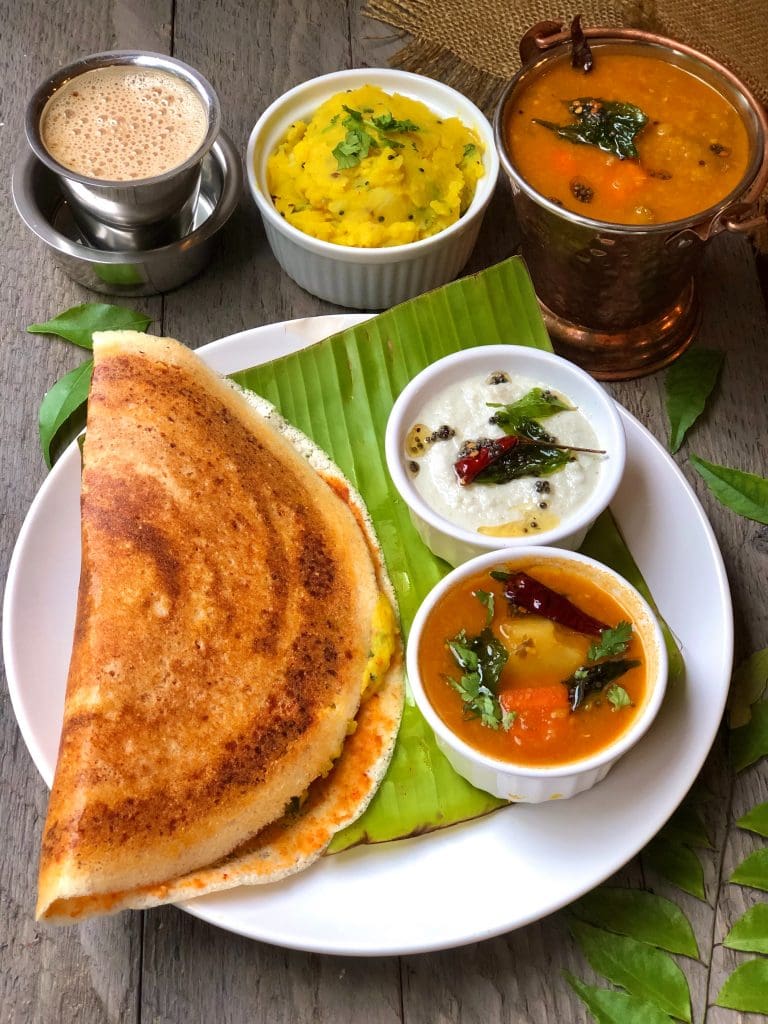
- Chow Chow Bath – Upma and Kesari baths are combined in a chow chow bath. The first is a spicy meal, while the second is sweet, and both are made with roasted semolina. Chillies, carrots, beans, peas, and other vegetables are used to make Upma. It goes well with pickle or kaayi chutney. Kesari bath, on the other side, is a sweet meal made with a variety of nuts and raisins.
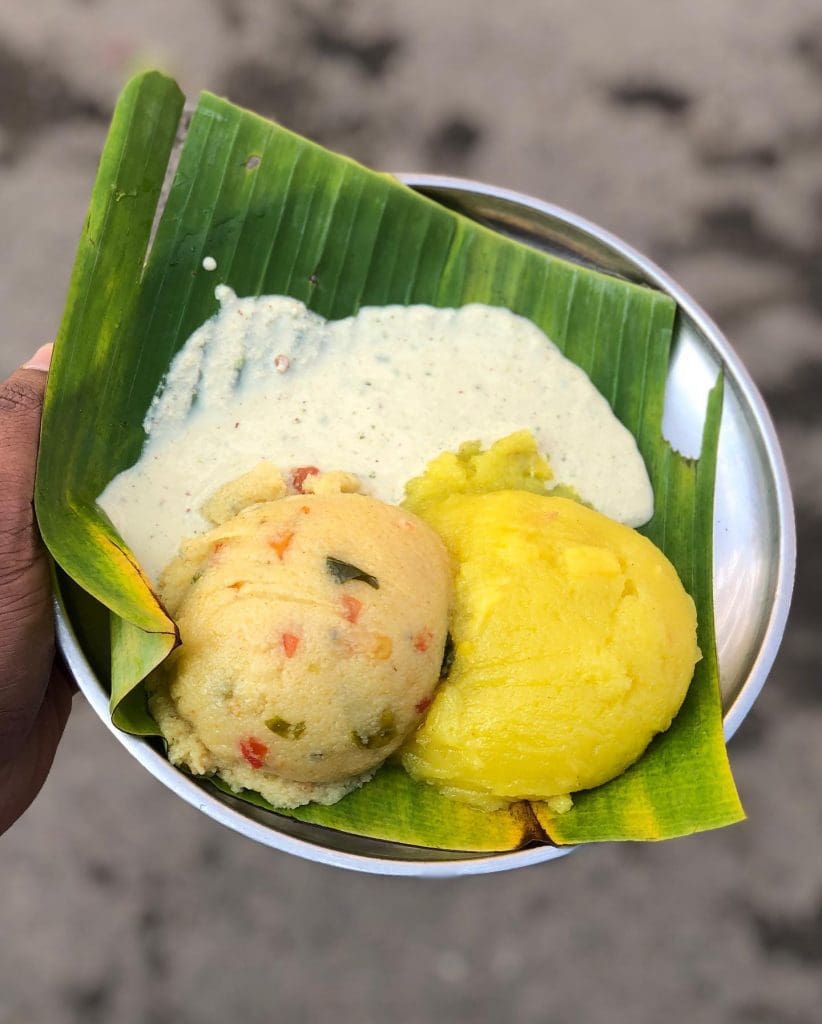
- Shavige bath – This delicious noodle dish is light but filling. While some may mistake it for noodles, they prefer to refer to it as ‘Karnataka-style noodles.’ Carrots, beans, peas, and other vegetables are frequently used.
- Puliyogre – Puliyogre is a sour, tamarind-based meal. It’s seasoned with a generous amount of groundnuts and curry leaves. Puliyogare has a fantastic flavour thanks to a combination of black sesame powder, coriander powder, and a pinch of hing.
- Vangi Bath – Rice and brinjal are used to make Vangi Bath. Some even combine potatoes with brinjal, which creates a wonderful flavour balance. Brinjal is often replaced with capsicum at some weddings.
- Chitranna – Chitranna is a simple dish made with a large number of groundnuts, chillies, and a squeeze of lemon. Some people even add sour mango, which gives it an incredibly acidic flavour.
- Bisi bele bath – Carrots, beans, potatoes, groundnuts, and toor dal, which are proportionally higher than rice, are used to make it.
Kannada wedding rituals are a beautiful tapestry of cultural richness, blending simplicity with serenity, and ritual with romance. Each ceremony, from the pre-wedding rituals like Nischay Tamulam and Naandi to the post-wedding celebrations such as Vidaai and Griha Pravesh, is infused with deep meaning and communal significance.
The attire, be it the groom’s veshti or the bride’s Naavari saree, adds to the elegance of the occasion, while the diverse and delicious culinary offerings like Masala Dosa and Bisi bele bath tantalize the taste buds.
These weddings are not just a union of two souls but a celebration of heritage, a testament to the enduring charm and richness of Karnataka’s cultural legacy. Through these rituals and customs, the essence of tradition and romance in Karnataka weddings continues to thrive, weaving new memories while honouring timeless traditions.
In brief
Pre-Wedding Rituals
- Nischay Tamulam: The Engagement Ceremony
- Naandi: Invoking Blessings for the Wedding
- Kaashi Yaatre: The Pilgrimage Ritual
- DevKarya: Seeking Divine Blessings
Wedding Rituals
- Mandap Pooja: Sanctifying the Wedding Venue
- Var Puja: Honoring the Groom
- Jaimala: The Exchange of Garlands
- Dhare Herdu: The Handover Ceremony
- Saptapadi: The Seven Sacred Steps
Post-Wedding Rituals
- Okhli: The Ring Finding Game
- Vidaai: The Farewell
- Griha Pravesh: The Bride’s Welcome
- Name Change Ceremony
- Visiting the Bride’s House
- Reception: Meeting the Family
Wedding Attire
- Traditional Attire for the Groom
- The Bride’s Ornate Dress
Festive Food at Karnataka Weddings
- Masala Dosa: A Savory Delight
- Chow Chow Bath: A Mix of Sweet and Spicy
- Shavige Bath: Karnataka-style Noodles
- Puliyogre: The Tamarind Rice
- Vangi Bath: The Brinjal-Rice Fusion
- Chitranna: The Lemon-Flavored Rice
- Bisi bele bath: The Mixed Vegetable Rice Delight
Read more: Lifestyle, Weddings & Wellness



